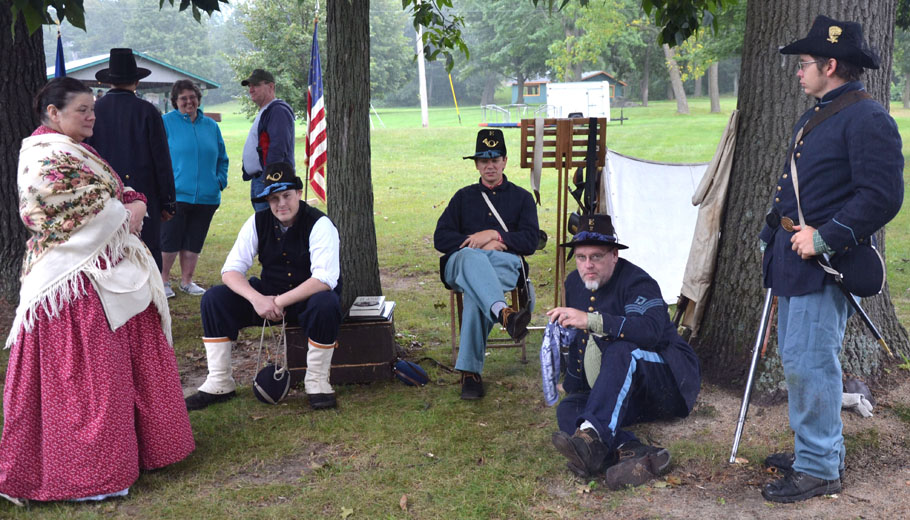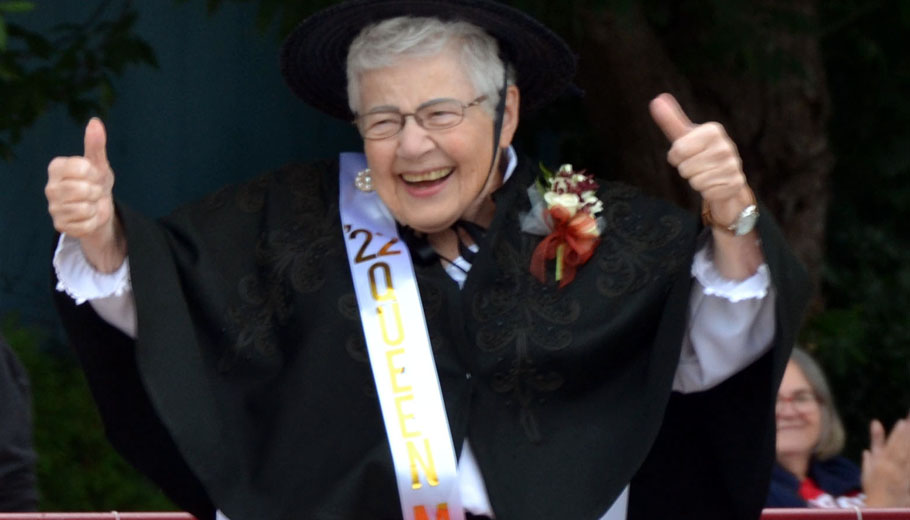
More history added this year in Weyauwega
By James Card
Rain and parades don’t mix but crowds still gathered along the sidewalk of Main Street with an eye on the gloomy sky.
The 61st annual Horse & Buggy Days parade narrowly escaped getting rained out but festivities later in the afternoon got caught in some showers.
King and Queen Howard Quimby and Marietta Paap led the parade and it was a classic mix of fire trucks, police cars, antique farm tractors, Shriners, Boy Scouts, the high school marching band, riders on horseback, vintage cars and trucks and one small pony pulling a buggy with two riders.
State Rep. Kevin Petersen marched in the parade, St. Peter Lutheran Church had a float celebrating the 150th anniversary of their congregation and also two newcomers were present in the parade: Premier Community Bank and the Refinery Church.
Besides the carnival rides and other events, there were two new attractions this year: guided historical tours of Weyauwega and a Civil War reenactment.

Touring Weyauwega
The Weyauwega Area Historical Society purchased a people carrier from the Iola Old Car Show and with the help of some high school students, they refurbished the trailer with new seating. Hitched to a truck and with a rigged roof of tarp, people climbed aboard with Brad Leonhardt as their guide.
“We’ve been working on this quite a while and we’re excited to show you the history of this beautiful town. We will not be able to show you everything today because that would take us hours. In fact we had to cut this [tour] back,” said Leonhardt.
The tour lasted 45 minutes and started in the parking lot behind city hall.
Affixed to the front of the people-carrier trailer was a flat-screen TV with a pre-loaded narrated slideshow.
As the tour glides from one city block to another, Leonhardt would point out buildings and black-and-white photos of the buildings would appear on the screen.
First off was the Hotel Hutchinson where President John F. Kennedy campaigned in 1960. From there, the tour winded through neighborhood streets and Leonhardt pointed out homes of historical significance and also public landmarks such as where the old city square used to be (the intersection near the library).
The tour also covered Weyauwega’s evolution of schools and post offices, the opera house and city hall.
Of more recent history, the tour passed the Robert Bloch house. It was here in Weyauwega where the author was inspired by Ed Gein of Plainfield to write the novel Pyscho, which Alfred Hitchcock later turned into a film of the same name.
Two tours were given before the last tour was rained out. This year the historical society plans to organize Christmas-themed tours of historical homes in Weyauwega and details are still being worked out.

Living History
At the far end of Maasch Community Park, a campfire smoldered in the sprinkles as six members of Company E of the 2nd Wisconsin Volunteer Infantry huddled under a cluster of large oak and pine trees.
“Well, this is a pretty good reenactment. They would have been staying out of the rain, too,” said Scott Boesel.
Nearby were three canvas pup tents keeping their gear dry and later the soldiers would be oiling their .58-caliber 1861 Springfield rifles to prevent rust forming on the bare metal.
“This is small and limited but this is a scenario of what camp life would have been for the soldiers here,” said Carla Blood, a re-enactor wearing a gown-like dress.
“When we did the 150th Gettysburg [reenactment], there were about 12,000 re-enactors there. The battles that we did were massive. It’s something we don’t see in the events that we do in Wisconsin. With our events, we can sometimes put 25 or 30 people on the field. But with these living history-type events, we try to get a dozen people and drill and interact with the public. Education is a big draw,” said Boesel.
At the park shelter, there was a display showing the role of Wisconsin Ladies Aid Societies in the Civil War.
Spread across picnic tables were what ladies would send to soldiers on the front lines. They sent bibles, quilts, and muslin bandages. They knitted socks, sewed uniforms and stitched mittens that had a separate covering for trigger fingers. In wooden boxes they packed onions, potatoes, apples and cloth bags of beans and nuts.
“Wisconsin ladies were known for impeccably packed boxes,” said Peggy Rowley. “The women went above and beyond or they might not have made it home.”
